The distinctive turkey tail mushroom (Trametes versicolor), with its striking resemblance to the fanned plumage of a wild turkey, is widely known as a medicinal mushroom. This common and beautiful mushroom grows wild across North America and is highly valued. If you’re searching for turkey tail, this guide will show you how to forage the medicinal one while differentiating it from its many lookalikes.
- Scientific Name: Trametes versicolor (Syn: Coriolus versicolor)
- Common Names: Turkey Tail
- Habitat: Dead hardwood
- Edibility: Inedible, used medicinally

Jump to:
All About Turkey Tail Mushrooms
Turkey tails earned their common names because the fruiting body looks much like the feather arrangement on a real turkey. In Japan, it’s known as “kawaratake,” which means “roof tile mushroom”—another great description of the cap decoration.
The turkey tail mushroom is a true chameleon of the fungal kingdom, showcasing a remarkable array of colors and patterns on its cap. From rich hues of brown and cinnamon to striking bands of white, gray, and even shades of blue and green, this polypore’s surface is an example of Mother Nature’s artistry.

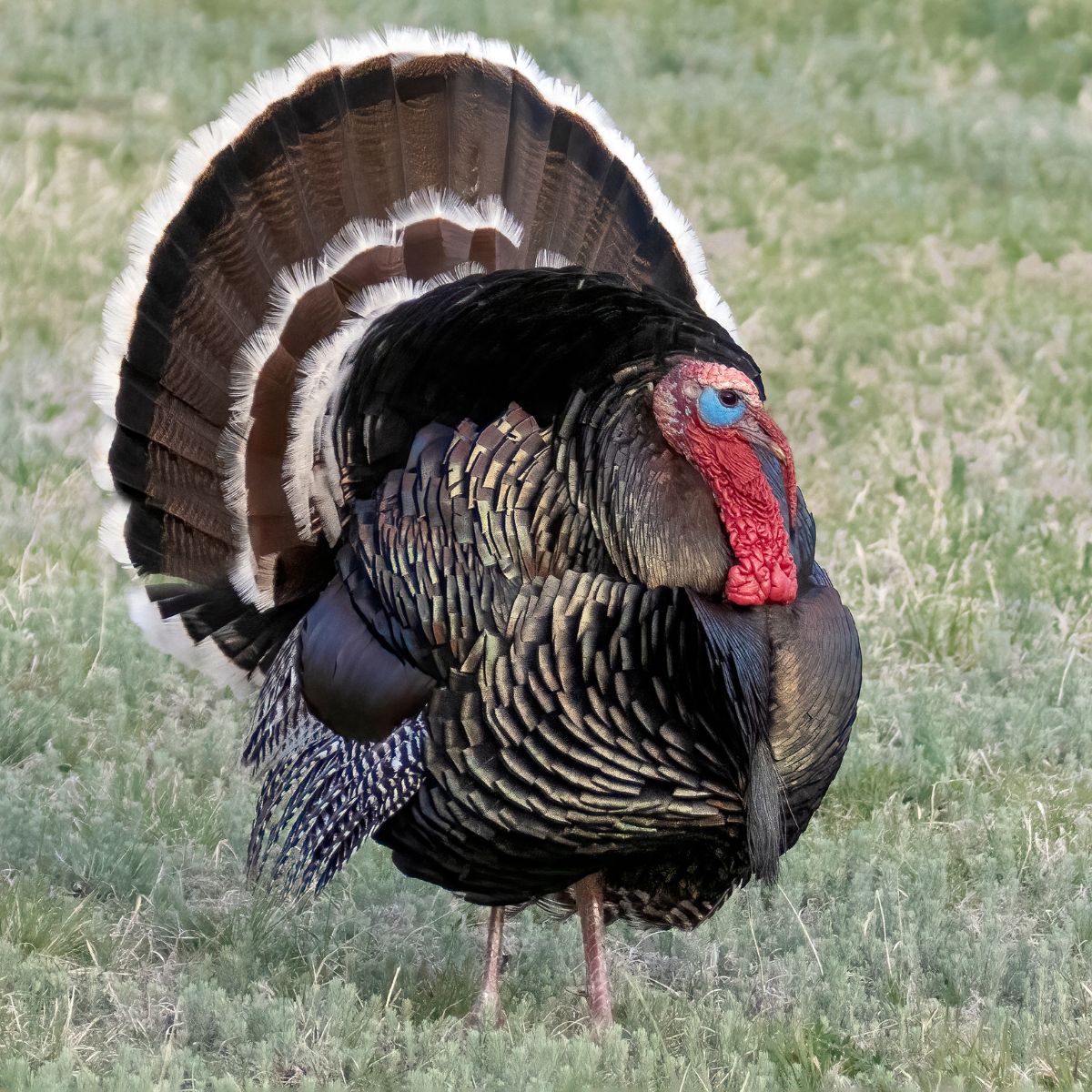
In traditional Chinese medicine, turkey tails have been revered for their purported health benefits. They are often consumed as tonics or brewed into teas. The mushroom’s reputation as a medicinal mushroom has caught on across the world, especially with recent studies backing up many of its traditional uses. It is currently being explored for its potential applications in complementary and alternative therapies.
As a saprobic fungus, the turkey tail thrives on the decomposition of hardwood trees, mainly fallen logs, and stumps. Its leathery, flexible caps can often be found growing in overlapping clusters on deadwood. By breaking down the lignin and cellulose in wood, Trametes versicolor plays a vital role in the forest ecosystem, returning essential nutrients to the soil and paving the way for new growth.
Identifying the Turkey Tail: A Comprehensive Guide
Season
This resilient fungus can be found throughout the year, though it is most prevalent during fall and winter. New fruit bodies tend to show up in fall, but because it is a tough polypore, it only deteriorates slowly. This means you can often find it throughout the year, although older specimens aren’t the best for foraging for medicinal purposes.
Habitat
Turkey tail mushrooms are saprobic and grow on decomposing wood. They prefer hardwoods, like oak, maple, and beech. But, they may also grow on conifers. These mushrooms often grow in overlapping clusters or dense rosettes. Or, they might grow like many dozens or hundreds of thin shelves from the side of a log or tree. Rarely is there just one fruiting body.
Turkey tails grow only from wood; they do not grow from the ground. This is a very widespread species found in North America, Europe, and Asia.


Identification
Cap and Body
The cap measures between 2 and 8 inches across and is fan-shaped, semicircular, or kidney-like. It is flat and densely velvety or hairy. The cap colors range from brown to gray to reddish-brown to blue to green and silverish—there is a lot of variation! This can make identification a little tricky, but there are other key characteristics that set it apart from lookalikes. The color depends a lot on the environment and access to nutrients.
The cap colors are displayed in alternating zones of texture and concentric bands. This is called concentric zonal coloring because the colors are separated and radiate outwards from a central point, the base of the fruiting body. The colors are usually quite different from each other—even if they’re mostly brownish, they’ll be very dark brown, then light tan, then buff or cream, and then cinnamon brown or something like that. The colors do not blend together; they contrast very noticeably.
Turkey tail fruiting bodies are thin and flexible. They do not get super thick, and they are not rigid. This means you can bend them easily.
These mushrooms do not have stems. Instead, they attach directly to the wood on which they’re growing.
Pores
The pore surface ranges from whitish to pale brownish. When young and prime for foraging, the underside will be pure white/cream-colored. This is a feature that differentiates it from many lookalikes. With age, the pores do turn brownish, which then makes it a bit more complicated to tell them apart from similar species.
Flesh and Odor
The flesh is insubstantial and leathery, with a thin black line separating the cap surface from the whitish interior. The turkey tail mushroom lacks a distinct odor or taste.
Spore Print
Its spore print is white.
Turkey Tail Key Identification Features
- White pore surface
- Zonal coloring on cap. The cap looks like a turkey’s tail—in shape and color.
- Densely hairy cap surface – velvety, suede but not shaggy
- Thin, flexible flesh
- No algae growth (no green coloring like many other bracket polypores)
- Growing on wood
- No stem
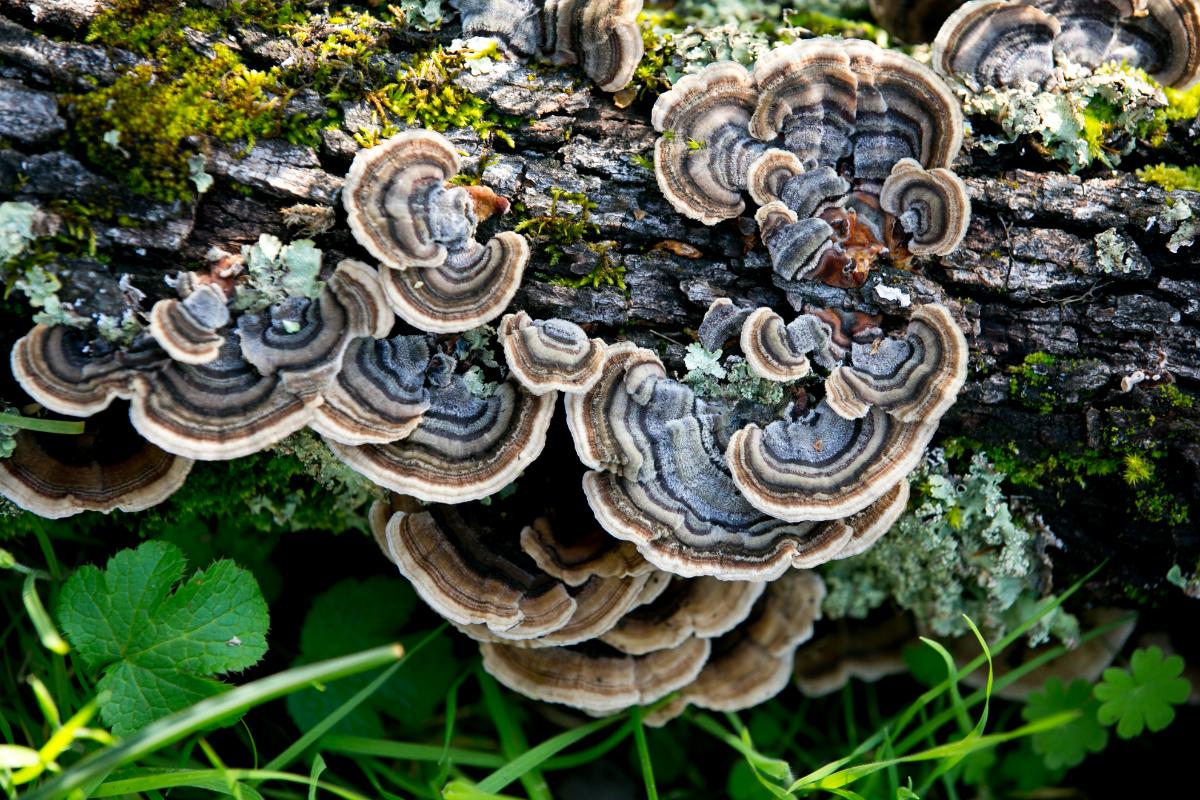




Turkey Tail Mushroom Lookalikes
False Turkey Tail (Stereum species)
While visually similar, these crust fungi don’t have the bright white pore surface of Trametes versicolor. Instead, false turkey tails have a smooth, spore-bearing underside.



Hairy Bracket (Trametes hirsuta)
This white-to-grayish cousin of the turkey tail lacks the striking, concentric color zones that define its more vibrant counterpart. The hairy bracket does have zones of coloring, but they are usually just one or two colors that aren’t highly contrasting. This mushroom is also much more hairy to the point of shaggy, while the turkey tail is more velvet or suede-like.

Trametes pubescens
Unlike the turkey tail, this species’ cap has subtle color shades within a single color range—it lacks the stark contrasting zones. It also has a thicker cap.

Trametes ochracea
Rigid and stiffer in texture, this mushroom contrasts with the thin, flexible nature of the true turkey tail. All you have to do is try to bend it, and you’ll know you haven’t found turkey tail.

Trametes villosa
This similar species is white to gray to tan without strong zonal coloring, making it look much more bland than the turkey tail mushroom. Its pores may be white but age to tan or gray and become tooth-like with maturity.

Violet-Toothed Polypore (Trichaptum biforme)
From the top of the cap, these two species look a lot alike. It’s also not uncommon to find these growing on the same log. However, there are some easy-to-see key differences once you flip the cap upside down to see the pores. The violet-toothed polypore, as the name suggests, has violet or light purple pores that turn tooth-like with age. This species is also often covered with green algae.

Smoky Polypore (Bjerkandera adusta)
The main difference between the turkey tail and the smoky polypore is the pores. Smoky polypores have gray to black pores, never white. Their caps are also usually less zone-like and tan, gray, or brown.

Mossy Maze Polypore (Cerrena unicolor)
This bracket fungus looks a bit like a turkey tail since it forms the same fan-shaped cap. However, this species is much duller in coloring and doesn’t have the very distinct zonal coloring of turkey tail. It is also very often covered in green algae. Its pores are also maze-like, which are very different from the turkey tail’s small, rounded pores.

Split Gills (Schizophyllum commune)
From above, split gill mushrooms look similar to turkey tails with brownish or tannish zonal coloring. But, when you look underneath, the difference is clear. Split gills have gills, not pores, under their cap.

Shiny Cinnamon Polypore (Coltricia cinnamomea)
Like the turkey tail mushroom, the shiny cinnamon polypore has deeply contrasting zonal coloring. This is a beautiful and very eye-catching species! There are some easy-to-see differences with close examination, though. The cinnamon polypore grows vase-shaped with a clearly visible stem. It also most often grows from the ground. The cap displays concentric zones of cinnamon brown (not grays, whites, or blacks) and is very shiny. Finally, the pore surface of this species is also cinnamon brown.

Ochre Spreading Tooth (Steccherinum ochraceum)
This crust-like bracket grows caps with zonal coloring but is usually grayer or tan and not as distinctively contrasting as the turkey tail. It also has teeth under the cap, not pores. The teeth are orangy or pinkish, not white like the turkey tail, either.
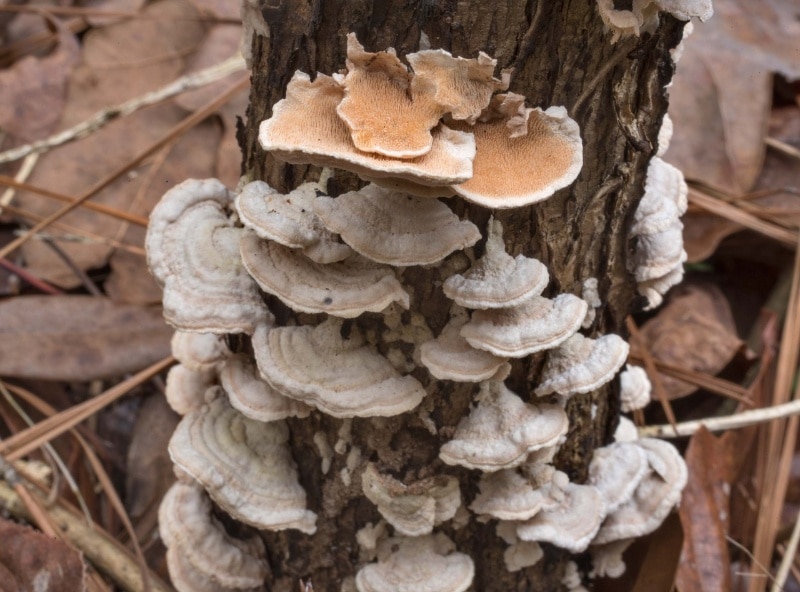
Turkey Tail Mushroom Edibility
The turkey tail mushroom is inedible due to its tough, leathery texture. This only means you don’t want to cook it up like a regular mushroom, as it will be quite an unpleasant experience.
Instead, turkey tail is used medicinally by infusing it in teas and tinctures and turning it into powder. Some people add them to soups or broths during the simmering stage—you just have to make sure to remove them before eating the soup!
Turkey tails have a subtle earthy flavor. Some adventurous chefs have even experimented with pickling or candying the mushroom, with mixed results
For more information about the medicinal and culinary uses of this mushroom, check out this post about Turkey Tails.

Medicinal Health Benefits of Turkey Tail Mushrooms
The turkey tail mushroom gets lots of attention for its purported medicinal properties. While scientific research is ongoing, preliminary studies have yielded promising insights into the fungus’s potential therapeutic applications.
One of the most extensively studied compounds derived from the turkey tail is Polysaccharide-K (PSK), a proprietary extract approved for clinical use in Japan as an adjuvant therapy for cancer treatment. There have been many clinical trials exploring the potential benefits of PSK in improving survival rates for gastric, colorectal, and esophageal cancers when used in conjunction with conventional therapies.
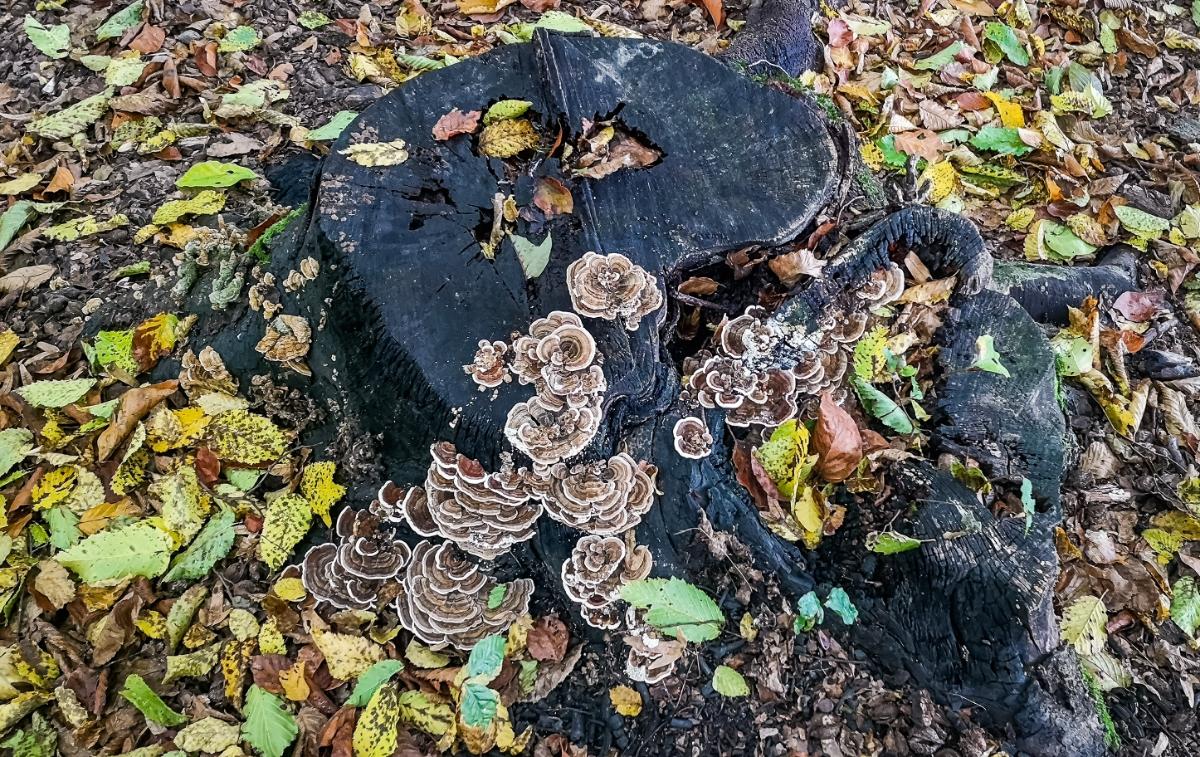
Additionally, Polysaccharide-peptide (PSP), another turkey tail extract, has shown promising immunomodulatory effects. It may benefit patients with advanced non-small cell lung cancer when combined with chemotherapy.
However, it is essential to note that while these preliminary findings are encouraging, the efficacy of turkey tail extracts in cancer treatment remains inconclusive. No long-term human studies have been done to verify all the findings.
Another issue is that over-the-counter products containing these extracts may vary in potency. They lack standardization which means a lot of companies get away with less than honorable practices. This is another reason to learn how to forage this mushroom for yourself.

Conservation Efforts: Preserving Turkey Tails
As with many wild fungi, the turkey tail mushroom faces potential threats from habitat loss, pollution, and climate change. Much of this is due to its value as a medicinal species and overharvesting or unsustainable harvesting. Please be considerate when you forage, practice sustainable harvesting, and always leave some behind to spore out. Efforts to preserve and protect its natural habitats are crucial for ensuring the long-term survival of this remarkable species.

Common Questions About Turkey Tail Mushrooms
Can you grow turkey tail mushrooms?
Yes, turkey tail mushrooms can be cultivated. They’re not super difficult to grow either. There are many mushroom companies who sell grow kits and spores.
How do turkey tail mushrooms fight cancer?
It is essential to understand that turkey tail mushrooms are not a cure for cancer. Instead, they can be used as a complementary therapy to help the body during cancer treatments. For decades, Japan has been using turkey tail extracts as a supportive cancer therapy. There is lots of study on these mushrooms but the way it works isn’t entirely clear. There have also been no long term human studies to verify the effectiveness of turkey tail in fighting cancer.
Does turkey tail have any toxic lookalikes?
No. Thankfully, turkey tail mushrooms do not have any dangerous lookalikes. However, they do have a ton of non-dangerous lookalikes.





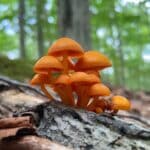


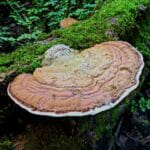
Leave a Reply